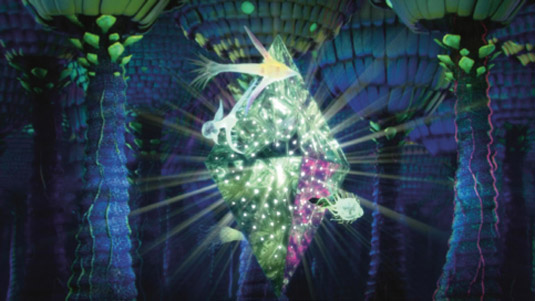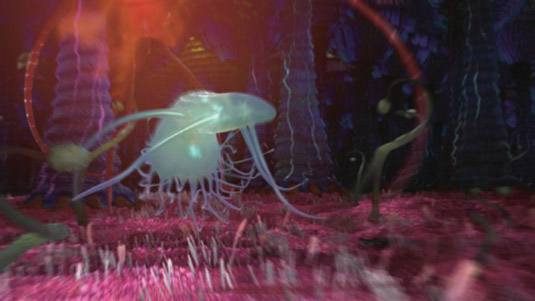Does this surreal animation spark your creativity?
Portals is a visual treat set in a bioluminescent world. Director Simeon Sokerov and concept artist Viktor Mazhlekov say its aim is to spark the imagination.
Viktor Mazhlekov has worked in a range of creative media, from painting and sculpture to animation and game design. In 2010 he started work on a series of oil paintings. As work on the series progressed, a new concept started to emerge – portals, the transition from one state to another.
The philosophy behind this concept, says Mazhlekov, is that we're not alone and everything in our universe is impermanent. Then it evolved again. "I started to imagine this whole world; this time in motion," Mazhlekov says. "I felt that this was the right moment to start work on my first animated film."
To animate Portals, Mazhlekov worked with director Simeon Sokerov. "We had difficulties both aesthetically and technically," says Sokerov. "The hardest part was to make a film that encompasses all our viewpoints with depth and detail, while at the same time preserving the general look and feel of the original paintings."
How did you get the project started?
VM: I already had the idea so the next step was the studio, and I knew I could count on Simeon and his studio, as I've worked with him previously on other animated films. We discussed what we needed to create the film, and I started to look for investment. I pitched the idea to Chaos Group, and in August 2012 we signed the contract.

What were you responsible for?
SS: I wrote the script, directed the film, created some music, and worked on most aspects of the CG.
VM: My main jobs were pre-production, story creation, concepting, aesthetics and financing. After the production started, I was responsible for coordinating everything to do with the film's style and aesthetics.
What 3D software did you use, and what was your production pipeline?
SS: Our main package was 3ds Max. We have developed hundreds of scripts and some plug-ins for it, and we know MaxScript well. We rendered with V-Ray: it's fast, accurate and has a rich set of features.
Daily design news, reviews, how-tos and more, as picked by the editors.
First we modelled all the characters and environments so the technical directors could rig them. The animators began work and artists started creating the textures. Next was assembling the scenes, lighting and rendering. Initially we did a base lights pack with a combination of standard and V-Ray lights. Then we rendered all the shots with low GI and anti-aliasing for light continuity.
When we got the result we wanted, we started tuning and optimising the scenes with materials and textures. Prior to rendering, we prepared the render elements needed for the characters and environments. It's a proven pipeline – the difference with Portals was that we used a large amount of V-Ray features in every shot.

What did you learn from Portals?
SS: Working on Portals didn't go as smoothly as we hoped. We should have done more in pre-production and gone deeper during the R&D stage, and we shouldn't have relied solely on Max for the larger-scale scenes; as it didn't provide the precision that we needed.
VM: We made a lot of mistakes. The largest was that I wasn't fully prepared for the production. I had never worked on a project like this, and I had many misses in the concepts that caused issues in the production process. But in the end we handled it.
This article originally appeared in 3D World issue 185.

The Creative Bloq team is made up of a group of art and design enthusiasts, and has changed and evolved since Creative Bloq began back in 2012. The current website team consists of eight full-time members of staff: Editor Georgia Coggan, Deputy Editor Rosie Hilder, Ecommerce Editor Beren Neale, Senior News Editor Daniel Piper, Editor, Digital Art and 3D Ian Dean, Tech Reviews Editor Erlingur Einarsson, Ecommerce Writer Beth Nicholls and Staff Writer Natalie Fear, as well as a roster of freelancers from around the world. The ImagineFX magazine team also pitch in, ensuring that content from leading digital art publication ImagineFX is represented on Creative Bloq.
